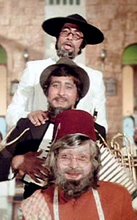
I have alway been interested by the Ramayana story and its characters (Sympathy for Ravan, Translating Ramayana and Other Thoughts, Sita the Bitch, Chat-up Lines of the Ancients), but am not as familiar with the story as I would like to be, so when I visited a couple of months ago, some things struck me as unexpected. At the time I scribbled them down on a brochure, and now I jot them down here to share my ignorance and thoughts with my friends. These unexpected realisations were:
1. Rama is shown with blue skin and a moustache.
Thinking about it, Krishna is blue, and Rama and Krishna are both avtars of Vishnu, so perhaps that is not so odd. There is some logic, though I have not previously seen Rama depicted as blue-skinned. Why should Vishnu be blue though? It was Shiva who was neel-kantha or blue throated, from drinking the poison of the cosmic ocean.
The moustache thing is fascinating. From casual observation, a majority of Indian men seem to have a moustache, but in the popular depictions of Hindu Gods and Epics, only the demons, the villains seem to have moustaches, while the male Gods are depicted clean-shaven and looking somewhat androgynous. Is this perhaps only a recent innovation? I was thrilled to see a more hirsute Indian hero.
2. Why does Ravana have a donkey's head as one of his 10 heads in this image? Also, why was he shown with a donkey's head only on this manuscript page (page 38), but none of the other pages?

3. Don't you love the crazy faces of the women in the photo? One has a disturbingly wide smile, one appears to be a Zombie. But even the Zombie has found a lover. Ravana's Lanka seems a haven for those who are different, a kind of Amsterdam of its day.
4. Why are there bears (yes, they do look like boars, but the commentary said bears) fighting in Rama's army? What is the story here?

5. Did you know monkeys come in two colours?
6. I was amused in a juvenile kind of way by the anatomical accuracy of the monkeys in the manuscripts. They all seemed to have visible male genitalia! If this casual observation was correct, this suggests that Rama's vanar-sena, or monkey army, was also exclusively male. This raises:
7. Why aren't there any female monkeys fighting? Are female monkeys not as good at fighting, and not even of some relative utility? Is war an exclusively male preserve across species? I don't know about the warrior capabilities of female monkeys, but it seems wasteful to leave them out fully!
8. This wasn't something I noticed, but rather I overheard. There were a group of serious sounding women discussing the Ramayana story. One said she was troubled as it began with a queen who controlled the king, and ended with a queen controlled by a king. This, she declared, made the Ramayana story quite problematic from a feminist perspective.
No comments!
